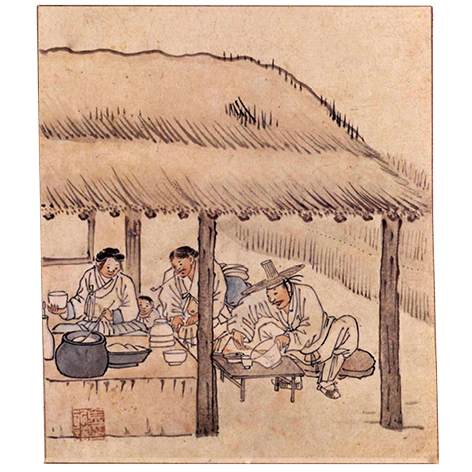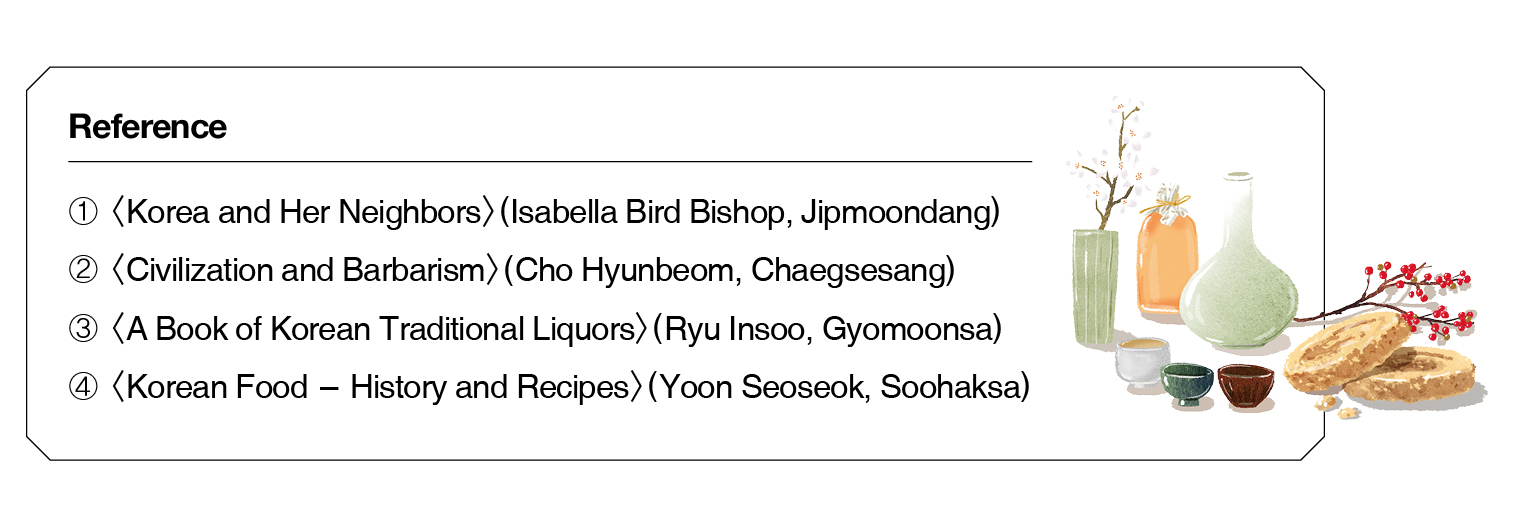한식 읽기 좋은 날
Vol 44. Harmony of Korean Food and Liquor
Korean Traditional Drinking Culture
Viewed from Jusageobae by Shin Yun-bok / HANSIK & Culture — Food Ingredients in K-Contents
Shin Yun-bok, along with Kim Hong-do, is a representative genre painter of the late Joseon Dynasty. His paintings are outstanding works of art and valuable historical materials that describe life at the time. His work, Jusageobae(酒肆擧盃), published in <Hyewon Jeonshincheop>, we can see a glimpse of the traditional drinking culture of our ancestors.
Article. Jung Younhye(History Columnist)
Reading the Scene in Jusageobae(酒肆擧盃)
Raise a glass to greet the bright moon, and hug a liquor jar to face the clear wind.(擧盃邀皓月 抱甕對淸風)
- Painting poetry in Jusageobae
|
|
| Source. Kansong Art Museum / <Jusageobae> by Shin Yun-bok |
Jusageobae, meaning, “raising a glass at a bar,” is a painting that depicts the scene of a tavern in Hanyang. On one spring day, when pink azaleas were in full bloom, five men visited the tavern. The class of the guests who visit the tavern in the painting is very diverse from a yangban(nobleman), wearing a wide hat and robe, to a byeolgam(official) of a martial art agency and a najang(duty officer) at Uigeumbu(today’s police station) wearing a black hat.
In fact, our ancestors enjoyed drinking freely, regardless of their status. During the Goryeo Dynasty, a Buddhist society, liquor was mainly manufactured and sold in large quantities at temples. However, as Buddhism was rejected during the Joseon Dynasty, mass production of liquor also disappeared. Instead, a small amount of liquor was produced in ordinary households so that they could use it in family events and ceremonies. As a result, bars did not prosper, and it was difficult to find people from different classes enjoying a drink together.
However, in 1739(the 13th year of King Jeongjo’s reign), the sinhaetonggong system was implemented, recognizing free commerce, the market was revitalized, and commerce developed significantly. As a result, gaekju(peddler’s inn) and taverns began to appear on ferries that transported goods. The main customers of these bars were very diverse, including low-level officials, such as byeolgam and najang, technical joongin(middle class between yangban and pyeongmin)(commoners), such as interpreters, and yangbans and sangmin(common people).
Such custom continued through the late Joseon Dynasty, and into the period of enlightenment. Isabella Bird Bishop, who traveled to Joseon during the enlightenment period, wrote in <Korea and Her Neighbors>, “Even the people of high class sometimes get drunk, and roll on the floor at the end of a feast.” The Catholic missionary, Daveluy, who was dispatched to Joseon during the enlightenment period, also recorded, “Even the king and the prime minister drink plenty of liquor in public. When drunk, people lose consciousness, and either roll on the floor or sleep to overcome the hangover. Still, no one seemed surprised or offended.”
 |
| Source. National Museum of Korea / <Jumak> by Kim Hong-do This painting, completed at the same time as the Jusageobae(酒肆擧盃), depicts the scenery of a small tavern, where a liquor jar full of makgeolli, a few liquor bottles, and glasses are arranged to greet guests. |
Anju Culture During the Joseon Dynasty in Paintings
What kind of liquors and anju(side dishes accompanying liquors) did our ancestors, who freely enjoyed drinking regardless of class, mainly consume? The bar in Jusageobae is a tavern where one could drink while standing, and the drinker could consume liquors and anju at a cheap price. At the taverns during the Joseon Dynasty, anju was included in the price of liquor, so a glass of liquor was drunk with a piece of anju.
In the picture, the jumo(owner) is sitting in front of the stove, and pouring drinks to the guests. She holds a small ladle in her hand, and there are dishes cluttered in front of the customers. Six of the dishes are bowls and small dishes, and two of them are dishes with a low heel. These dishes must have contained a variety of anjus. During the Joseon Dynasty, dried snacks made with various types of jerkies, salted fish, jeon, hoe, and hot pot were eaten as anjus. For dry anjus, meat and fish jerkies, pine-nut kernels, walnut, and eunhaeng(maidenhair tree nut) were used. The meat jerky was thinly sliced, and dried with salt or soy sauce. The fish jerky was made by thinly slicing white fish, seasoning and drying it. Moreover, dried abalone, dried octopus, dried pollack, and fish roe were used for anju. Salted fish was enjoyed with warm yakju, and salted oyster and salted pollack tripe were often used. Jeon was a typical anju made with fish, meat, and vegetables. Hoe(sliced raw fish) mainly used seasonal ingredients, as parboiled dish using croaker was eaten during the summer, and yukhoe(raw beef) was eaten in the autumn and in the winter. Beef was most commonly used for hotpot, but, in some cases, raw oysters, octopus, fatsia shoot, and various vegetables were also used. Moreover, gujeolpan(platter of nine delicacies), milssam(beef and vegetables wrapped in wheat crepes), pyeonsu(square-shaped dumpling), hoe, pyeonyuk(boiled beef/pork slices), kimchi, and seasoned vegetables accompanied the drinks.
Our Diverse and Splendid Traditional Liquors
The types of liquor were also very diverse. Looking at the records remaining in the literature, we can find countless liquor recipes from the Joseon Dynasty in 50 or so literatures from <Sanga Yorok> published in the 1450s, the first classical cookbook in Korean <Umsik Dimibang> in the 1670s, <Yangjubang> in the 1800s, and <Joseon Moosang Sinsik Yori Jebeop> in the early 1900s. Isabella Bird Bishop, a traveler during the enlightenment period wrote about our traditional liquor in her book, <Korea and Her Neighbors>, “The liquors of Joseon range from a white drink that looks similar to buttermilk and tastes savory, to a strong liquor with mild texture, strong scent diluted with water, and intense burning taste.”
Jusageobae is set in a late spring day when azaleas are in full bloom. Perhaps the drinks the customers drank in the painting were brewed in the early spring, and drank them from the late spring through the summer. Yakju, such as sogokju, dugyeonju, dohwaju, and songsonju, or soju, such as gamheungro, byeokhyangju, yigangju, jukryeokgo, gyedangju, nosanchun, and samhaeju, were representative springtime traditional liquors that our ancestors drank. In the summer, they mainly made and drank gwahaju(過夏酒), which does not spoil even in the hot and humid weather. Gwahaju is a type of liquor made by mixing fermented and distilled liquors. This is the same as making port wine in Portugal. For this reason, gwahaju also has high alcohol content and a sweet taste like port wine. Moreover, changpoju, sindoju, gukhwaju, and googijaju were also enjoyed in the summer.
These diverse traditional liquors of Korea gradually disappeared one by one during the Japanese colonial period. When Japan temporarily permitted the gayangju license in the 1930s, 370,000 traditional liquors obtained the license. But now, only a handful of liquors are made using the remaining literature and old methods.
However, in recent years, efforts are being made to revive and change traditional liquor to continue its legacy. It is particularly encouraging that young brewers are leading this change. They are reviving traditional liquor-making methods by studying old literature, while using new manufacturing methods and raw materials to create their own unique, never-before-seen traditional liquor.


 한국어
한국어
 English
English







